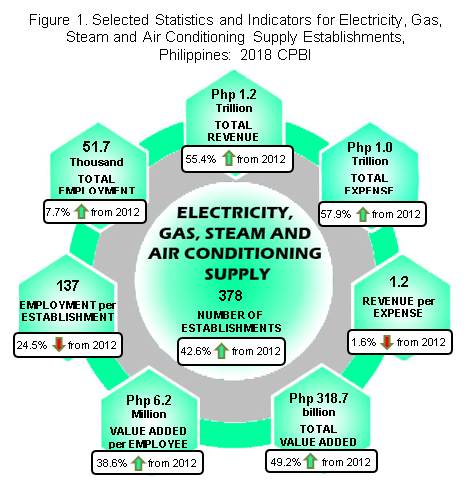Industry Section D includes two industry sub-classes covering the operation of electric and gas utilities, which generate, control, and distribute electric power or gas. The provision of steam and air-conditioning supply is also covered.
Figure 1 presents the selected statistics on the number of establishments, total employment, total revenue, total expense, and total value added. It also includes ratios on employment per establishment, revenue per expense, and value added per employee. Growth rates on these selected statistics and indicators from the results of the 2012 CPBI are also presented. (Figure 1)
Total number of establishments in the industry reached 378
In 2018, a total of 378 establishments were engaged in electricity, gas, steam, and air conditioning supply industry which indicates a 42.6 percent increase from the 265 establishments recorded in 2012.
Specifically, the establishments engaged in this industry belong to two specific industry sub-classes: 1) the electric power generation, transmission, and distribution; and 2) the manufacture of gas; distribution of gaseous fuels through mains. (Table 1, and Figure 1)
Central Luzon accounted for the highest number of establishments
Of the 378 establishments engaged in the industry, Central Luzon registered the highest number with 46 establishments or 12.2 percent of the total.

This was followed by NCR and CALABAZON with 43 establishments (11.4%) and 38 establishments (10.1%), respectively. ARMM and Zamboanga Peninsula with 6 and 7 establishments, respectively, were the regions with the least number of establishments. (Table 3A, and Figure 2)
NCR employed the highest number of personnel
The electricity, gas, steam, and air conditioning supply industry generated a total employment of 51,670 in 2018 which posted a 7.7 percent increase from the 47,973 total employment generated in 2012. (Table A, and Figure 1)

The National Capital Region was the highest among other regions in terms of number of employees who worked in the industry. The region employed 8,953 persons or 17.3 percent of the total industry employment. This was followed by Central Luzon with 5,928 (11.5%) employees CALABARZON with 5,328 (10.3%) employees. (Figure 3)
Additionally, 15,767 workers on sub-contract agreement or under manpower agencies/contractors were also recorded. Among regions, Eastern Visayas engaged the highest number of workers under sub-contract agreement with 5,500 or 34.9 percent of the total, followed by Central Visayas with 3,158 workers or 20.0 percent. (Table 3)

Employees in NCR received higher average annual compensation than other regions
A total of PhP 44.3 billion was spent by the industry for the compensation of its employees. On the average, a paid employee received PhP 865,207 as annual compensation. (Table 1)
Among regions, establishments in NCR spent the highest average annual compensation of PhP 1.6 million per paid employee, followed by CALABARZON with PhP 1.4 million and Eastern Visayas with PhP 1.0 million. All other remaining regions, except Davao with Php 937,031, had an average lower than the national level. (Table 3, and Figure 4)

NCR generated the highest revenue, and incurred the highest expense
The total revenue generated by the industry in 2018 amounted to PhP 1.2 trillion, an increase of 55.4 percent from the PhP 777.8 billion recorded in 2012. Moreover, the industry spent a total of PhP 997.1 billion in 2018 which indicates a 57.9% increase from the total expense in 2018 amounted to PhP 631.6 billion. (Table A, and Figure 1)
Among all regions, NCR generated the highest revenue with PhP 341.5 billion or 28.3 percent of the total. The region incurred expenses amounting to PhP 296.5 billion or 29.7 percent, also the highest share to the total expense of the industry. CALABARZON ranked second with PhP 257.5 billion revenue generated contributing 21.3 percent to the total revenue, with corresponding expense of PhP 207.7 billion or 20.8 percent. Central Luzon generated the third highest revenue of PhP 143.1 billion (11.8%) and incurred expense of PhP 114.5 billion (11.5%). (Table 3A, and Figure 5)

CAR posted the highest revenue per expense ratio
The PhP 1.2 trillion total revenue generated and the PhP 1.0 trillion total expense incurred by the industry translated to a revenue-expense ratio of 1.2. This shows that, the electricity, gas, steam, and air conditioning supply industry earned 20 centavos for every one-peso expense.
Among regions, the Cordillera Administrative Region posted the highest revenue-expense ratio at 1.5, followed by Ilocos Region with 1.4. The ratios of these two regions are higher than the national level. (Table 4)
CALABARZON led in terms of value added
The total value added generated by the industry in the production of goods and services totalled to PhP 318.7 billion. From the PhP 213.5 billion recorded in 2012, the value added increased by 49.2 percent. (Table A, and Figure 1)
The highest recorded value added with 21.1 percent was contributed by CALABARZON which generated PhP 67.2 billion. NCR ranked second with PhP 62.5 billion or 19.6 percent share to total, followed by Central Luzon with PhP 45.1 billion with 14.2 percent share. (Table 3A, and Figure 6)

DENNIS S. MAPA, Ph.D.
Undersecretary
National Statistician and Civil Registrar General
